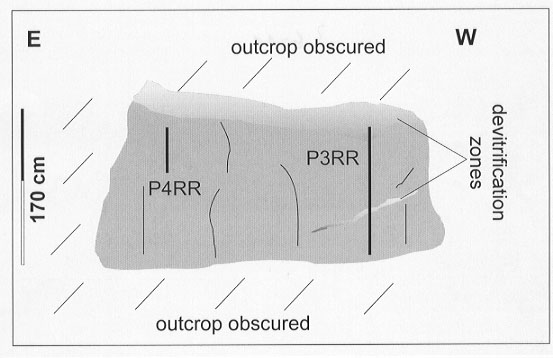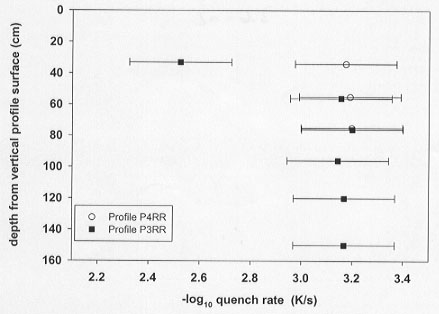

The predominantly explosive behavior of silica-rich volcanoes is sometimes associated with the passive extrusion of dome lavas or lava flows. Their high viscosity frequently inhibits crystallization upon cooling, resulting in a predominance of glass-rich flows. The presence of a glass phase allows an assessment of the cooling history of the flows via relaxation geospeedometry using differential scanning calorimetry. The quantification of enthalpic relaxation upon reheating of the glass into the supercooled liquid field is a direct means to model the cooling history of the melt within the glass transition interval. The methodology (Tool-Narayanaswamy model) is described in detail in the 1994 Annual Report.
The aphyric Rocche Rosse calc-alkaline rhyolite flow (agpaitic index = 0.96) of Monte Pilato, Lipari (Italy) was extruded in the 6th century A.D. following an explosive vent-clearing episode. The flow is 1.5 km long and 900 m wide with an average thickness of 80 m. Ramp structures, which vary in thickness from meters to tens of meters, are bounded by sub-horizontal shear planes and are exposed at the flow front, dipping gently towards the source area. We sampled a series of profiles within the ramps in order to study their thermal history; in addition we investigated obsidian fragments from the underlying explosion breccia on Monte Pilato.
There is a marked difference in the deformation behavior of obsidian within the ramps. Material along the shear planes shows in-situ brecciation whereas the interior of the flow lobes deformed viscously. Two profiles from the interior of a flow ramp within the frontal obsidian flow carapace were investigated in detail (Fig. 3.6-11). Hydrothermal alteration along cracks and joints resulted in the devitrification of the uppermost portion of profile P3RR. Samples taken in the center and lower part of the lobe display the uniform cooling behavior of a single unit. Cooling rates show only minor variations around 0.04 K/min (60 K/day). The influence of devitrification on the thermal modeling may become clear when we compare the uppermost samples of both profiles, sampled 2 m apart within the same flow-unit. The slightly devitrified upper part (P3RR, 30 cm depth) of the cooling unit suggests a faster cooling towards the top of the flow ramp at rates of 0.2 K/min (Fig 3.6-12). However, cooling rates of the pristine glass adjacent to the altered zone (P4RR) are indistinguishable from the pristine portions of P3RR. The hydrothermal alteration of the upper parts of profile RRP3 is also indicated by an increased water content of 0.21 wt% compared to values around 0.15 wt% within all other samples, though major element chemistry of studied samples remains unchanged. Unfortunately, both upper and lower extent of the sampled profiles is obscured in the field inhibiting the assessment of the overall lobe thickness. However, faster cooling seems to have occurred toward the base of the outcrop, where cooling rates increase steadily to 140 K per day. This suggests the presence of a thermal boundary not far below the base of the outcrop.
 |
Fig. 3.6-11:Schematic illustration of the investigated outcrop at the frontal obsidian carapace of a Rocche Rosse rhyolite flow, Lipari. The two vertical profiles (40 and 140 cm thick) were sampled 2 m apart. Note the alteration zone within the upper and central part of P3RR along cracks perpendicular to the columnar jointed dense obsidian. |
The cooling rates modeled for the obsidian of Rocche Rosse are more than 1 order of magnitude higher than those modeled for peralkaline phonolite flows on Tenerife, Canary Islands (see this Annual Report). Taking into account the overall geometry of the flow and its heat budget, cooling rates of the order of tens of Kelvin per day at the flow front seem to represent a minimum cooling threshold to sustain flow in highly viscous rhyolitic lavas. The modeled cooling rates reflect the overall thermal history of the ramps at the flow front. Their cooling behavior governs the rheology of the entire flow, as they are indicators of the last stage of viscous deformation before the flow came to rest. Brittle fragmentation along shear planes at flow lobe surfaces, exposed in other ramps, suggests ongoing viscous flow of the interior of the individual ramps, whereas those parts in contact with ambient atmosphere cooled below their glass transition temperature more quickly, resulting in in-situ-brecciation. Future studies will involve thermal modeling of entire flow ramp profiles and assessment of the cooling rates associated with brittle deformation. Calorimetric geospeedometry therefore allows the mapping of individual cooling units at the flow front as a function of flow-unit thickness.
 |
Fig. 3.6-12: The cooling rates within the flow ramp as a function of vertical depth. The studied profiles show two distinct features. First, cooling rates between 40 and 120 cm depth are indistinguishable within error and exhibit values of 2 K/hour, suggesting a uniform cooling behavior at this ramp within the frontal obsidian carapace of the flow. Second, the uppermost sample of profile P3RR from within a slightly devitrified, possibly hydrothermally altered, portion of the ramp suggests faster cooling towards the top. Faster cooling (6 K/hour) toward the base of the outcrop suggests the presence of a thermal boundary at the lower ramp surface. This boundary is not presently exposed. |

Tel: +49-(0) 921 55 3700 / 3766, Fax: +49-(0) 921 55 3769, E-mail: bayerisches.geoinstitut(at)uni-bayreuth.de
 Previous page
Previous page